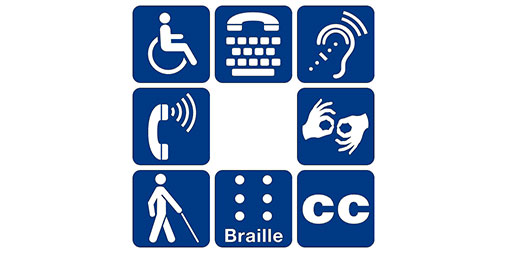Considerations for Your Company’s Website Accessibility Policy

We previously discussed the uncertainty concerning whether the Americans with Disabilities Act (ADA) applies to websites of private businesses and, if so, the specific requirements that would apply. We noted that even if businesses are not legally obligated to make their websites ADA-compliant, they must be aware of the status of the law concerning web accessibility. Below, we address why businesses should consider adopting a formal web accessibility policy and present the most important considerations when assessing the issue.
The Basics
A web accessibility policy is a formal policy adopted by a business or institution to formalize its commitment to making its web presence accessible to individuals with various disabilities, including those who are vision and hearing impaired. Current best practices are reflected in the Web Content Accessibility Guidelines released by the World Wide Web Consortium, an international organization. These guidelines provide detailed standards regarding the creation and maintenance of websites that are as accessible as possible to disabled individuals and should serve as the starting point when discussing the adoption of a web accessibility policy.
All New Websites Should be Compliant
Any web accessibility policy should separately address existing and future websites. As to future websites, businesses should commit to creating only content that complies with the guidelines. Doing so will avoid additional future costs and demonstrate an immediate commitment to web accessibility. The opposite is also true. Creating new content that has accessibility barriers is inconsistent with adopting a web accessibility policy and sends a mixed message about a business’s commitment to web accessibility. Moreover, to the extent the ADA applies to websites, creating additional content that does not comply with the guidelines potentially exposes a business to greater liability.
Modifying Existing Websites
The more difficult aspect of a web accessibility policy concerns how to modify existing websites with accessibility barriers to ensure compliance with the guidelines. At first blush, this may seem a relatively straightforward and simple process readily accomplished with a few “quick fixes.” But a cursory review of the Web Content Accessibility Guidelines illustrates that for many businesses, web accessibility will be a long-term and expensive process. This is particularly true for businesses with large web presences and those without in-house staff capable of performing the required modifications.
Prioritize Important Content
Compliance does not happen overnight. For this reason, businesses should prioritize important content when deciding what to make compliant. This will make a business’s most critical websites quickly available to the broadest audience and demonstrate a commitment to web accessibility. There are a variety of methods for prioritizing content. Initially, a business might identify specific content that is integral to the use of its website, such as the homepage or websites that provide directions on how to contact the business. An alternative method is to create objective criteria to determine when certain websites will be made complaint. For example, a business may prioritize websites that receive the top 10 percent of web traffic among all of its websites.
Specific Exclusions
A policy should specifically state what is covered, and just as importantly, what is not. This will be particularly significant with respect to providing a realistic estimate of the cost and time needed to ensure compliance. There are several specific categories of content that a business may want to consider excluding from its web accessibility policy. For example, while this article mainly addresses web accessibility, there are similar concerns about accessibility to mobile apps, electronic communications, and other technological platforms. Likewise, many businesses provide files for users to download, such as PDFs and software. Increasingly, businesses are permitting users to create their own online content, such as a publicly-accessible profile or internal social network hosted by the business’s website. In all of these circumstances, it may be impractical or impossible for businesses to ensure that this content complies with the guidelines, and they should consider whether to exclude such content from their policies.
General Exclusions
In addition to the specific exclusions discussed above, it is also advisable to include a “catchall” provision to provide your business with flexibility and avoid committing absolutely to making all content accessible to individuals suffering from any disability. Importantly, even to the extent the ADA applies to websites, it does not require businesses to undertake unreasonable efforts or excessive costs to ensure compliance. A web accessibility policy should acknowledge that there may be certain websites or types of content for which it would be impracticable to follow the guidelines. It is advisable to include a provision in a web accessibility policy permitting exclusion on a case-by-case basis and to identify objective criteria, including compliance costs, that will be used to make that determination.
Third Party Contracting
Businesses are increasingly contracting with third-parties to provide information technology products and services, including website development and maintenance. For this reason, web accessibility policies should include a provision requiring that IT contracts with third-parties contain a requirement that all products and services comply with the policy. It is advisable to expressly mention the web accessibility policy as a condition of performance, to attach the policy as an exhibit to the contract, and to provide a remedy for non-compliance.
Establish Deadlines But Be Realistic
A web accessibility policy, or policy addendum, should include deadlines by which specific projects will be completed. For example, a policy might provide that as of a certain date, all future websites must comply with the guidelines, and that by a different date, all third-party IT contracts must contain web accessibility provisions. These deadlines should be flexible enough to account for unanticipated developments. While there may be some simple fixes that remove access barriers, optimal accessibility is an intensive and ongoing process. For these reasons, businesses should create specific, but reasonable, deadlines for completion of specific projects.
Follow Your Policy
It is important to not only create a web accessibility policy but to follow it. As addressed we previously discussed, there has been a recent surge in litigation and threatened litigation involving claims that private businesses violate the ADA by maintaining websites with access barriers. Though the ADA’s applicability to websites remains uncertain, any business that adopts a web accessibility policy can expect any failure to comply with its own policy to be featured evidence in an ADA lawsuit.
Don’t Reinvent the Wheel
Many businesses lack sufficient in-house resources to perform all the tasks likely to be required by the adoption of a web accessibility policy, particularly given that web accessibility is a very specialized and relatively new niche of web development. Consequently, even businesses with substantial in-house IT resources and experienced IT staff should not expect to be able to perform all web accessibility projects without turning to third-party resources or retaining additional staff. Fortunately, there are businesses that specialize in web accessibility. They can both review existing websites for compliance, and remediate any problematic websites to eliminate access barriers. We highly recommend that businesses, particularly those with unsophisticated information technology departments, confer with and consider retaining one of these specialized consultants. It is advisable to retain third-party consultants through an attorney to establish an attorney-client or work product privilege as to communications with the consultant and the consultant’s work product.
Adam Schwartz is a shareholder with Carlton Fields in Tampa His practice primarily focuses on the defense and investigation of civil qui tam whistleblower claims, internal investigations and white collar criminal defense. Jonathan DeSantis is an associate with Carlton Fields in Tampa. His practice focuses on corporate trial practice and complex commercial litigation.Both authors advise entities on web accessibility and the potential applicability of the Americans with Disabilities Act to websites.

